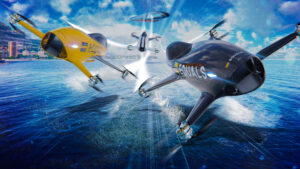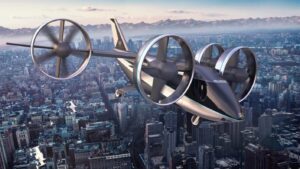For decades, the idea of flying cars has been the stuff of science fiction, appearing in books, movies, and TV shows as a symbol of the future. From The Jetsons to Back to the Future, these flying machines have captivated imaginations. But today, this once far-fetched idea is closer than ever to becoming a reality. Advances in technology, coupled with the demand for efficient transportation, are turning flying cars into a viable mode of transport. This article explores the journey from fiction to fact, examining the technological progress, challenges, and future potential of flying cars.
The Origins of the Flying Car Dream
The concept of flying cars first emerged in the early 20th century, at the dawn of the automobile and aviation eras. Visionaries like Henry Ford envisioned a future where cars could take to the skies, freeing people from the constraints of road traffic. Nonetheless, the idea persisted, and flying cars became a staple of futuristic fiction.
The show depicted a utopian world where flying vehicles zipped through the sky, providing effortless transportation.
The Technological Breakthroughs
Fast forward to the 21st century, and significant technological advancements have begun turning science fiction into science fact. Several innovations have laid the groundwork for the development of flying cars:
- Electric Propulsion: One of the biggest challenges in creating flying cars has been developing. However, electric propulsion systems, particularly those powered by lightweight lithium-ion batteries, have opened new possibilities. Electric Vertical Takeoff and Landing (eVTOL) technology, in particular, is a game-changer. These systems allow flying cars to lift off and land vertically, much like helicopters, without the need for a runway.
- Autonomous Technology: Another critical development is the rise of autonomous driving technology. Autonomous flying cars eliminate the need for skilled pilots, making the technology accessible to a broader population. With onboard sensors, cameras, and sophisticated algorithms, these vehicles can navigate complex airspace and avoid obstacles.
- Lightweight Materials: Advances in materials science have led to the development of stronger, lighter materials like carbon fiber and composites. These materials are essential for flying cars because they reduce the overall weight of the vehicle, improving fuel efficiency and range.
The Major Players in the Flying Car Race

Several companies and startups are vying to be the first to bring flying cars to market. Each company has its unique approach, but they all share the common goal of revolutionizing transportation. Some of the key players include:
- Terrafugia: Terrafugia, a subsidiary of the Chinese company Geely, is one of the most well-known names in the flying car industry. The company’s flagship vehicle, the Transition, is a hybrid car-airplane that can drive on roads and fly in the sky. The Transition has a wingspan of 27 feet and can reach speeds of up to 100 mph in the air.
- company’s AeroMobil 4.0 is a sleek, futuristic-looking vehicle capable of both driving on roads and flying. The AeroMobil 4.0 features folding wings and can switch between driving and flying modes in just three minutes. The company hopes to target the luxury market, offering a unique and premium flying car experience.
- Urban Aeronautics: Urban Aeronautics, an Israeli company, is developing the CityHawk, an eVTOL flying car designed for urban environ
- Joby Aviation: Joby Aviation, a California-based company, is focused on developing all-electric flying cars for the air taxi market. Their eVTOL aircraft has a range of over 150 miles and can carry four passengers at speeds of up to 200 mph. The company has secured substantial funding and is working closely with regulators to bring its flying cars to market. Joby Aviation’s vision is to create a network of flying taxis that can transport people across cities quickly and efficiently.
The Challenges and Obstacles
While the flying car phenomenon is undoubtedly exciting, several significant challenges need to be addressed before flying cars can become mainstream.
- Regulatory Hurdles: The biggest obstacle to widespread adoption is the regulatory environment. Flying cars operate in a gray area between traditional cars and airplanes, and governments are still figuring out how to regulate them.
- Infrastructure: Flying cars will require new infrastructure, such as vertiports for takeoff and landing, charging stations, and air traffic management systems . Additionally, creating dedicated air lanes for flying cars will be essential to ensure safety and prevent congestion in the skies.
- Cost: Initially, flying cars are likely to be prohibitively expensive for most people. The cost of developing and manufacturing these vehicles is high, and early models will likely be marketed to wealthy individuals or businesses.
- Safety Concerns: Safety is another major challenge. Flying cars must meet stringent safety standards to ensure that they are reliable and can operate without endangering passengers or people on the ground. Issues like mechanical failures, mid-air collisions, and emergency landings need to be addressed before flying cars can gain public trust.
The Future of Flying Cars

Despite these challenges, the future of flying cars looks promising. Many experts believe that flying cars will play a significant role in the future of urban transportation, particularly in congested cities where traditional road infrastructure is overburdened. Flying cars could reduce traffic, shorten commute times, and offer a new level of convenience and efficiency.
Companies like Uber and Lyft have already expressed interest in developing flying car networks, which could revolutionize ride-hailing services.
Conclusion
The incredible flying car phenomenon is no longer confined to the realm of science fiction. With advances in electric propulsion, autonomous technology, and lightweight materials, flying cars are on the verge of becoming a reality. While there are still significant challenges to overcome, the progress made in recent years is undeniable. From luxury flying cars to air taxis, the future of transportation is poised to take flight.

